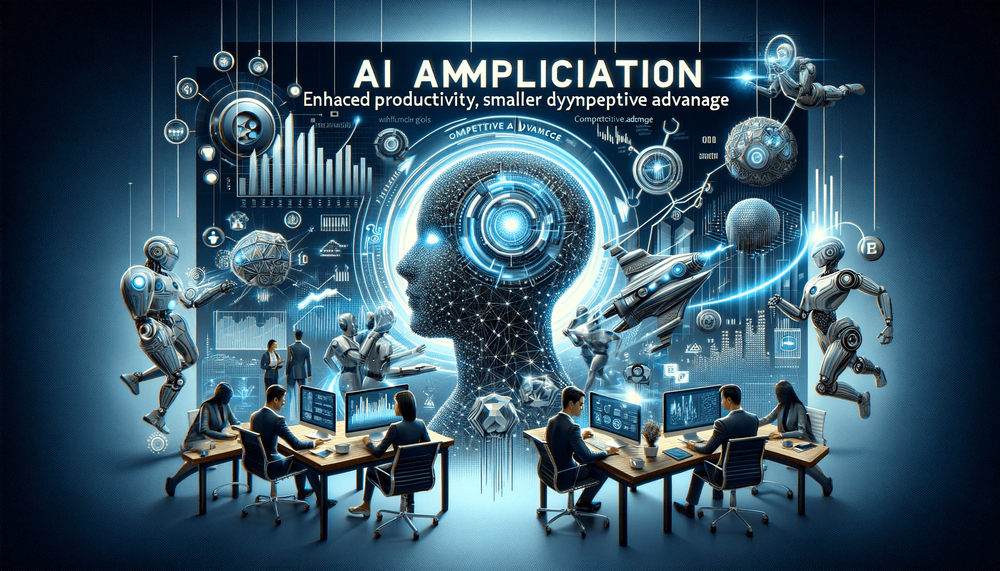AI Amplification in DeFi: Transforming Team Dynamics and Productivity
Introduction
In the rapidly evolving landscape of Decentralized Finance (DeFi), the integration of Artificial Intelligence (AI) is proving to be a game-changer. Unlike automation, which replaces human effort, AI amplification enhances the capabilities of developers and professionals, enabling smaller teams to achieve what traditionally larger teams could. This article explores the implications and benefits of AI amplification in the DeFi sector.

Enhanced Productivity
AI tools streamline workflows, optimize decision-making, and accelerate development processes. This leads to significant increases in output and efficiency, allowing developers to handle more complex tasks and larger workloads more quickly. The result is a notable boost in productivity, enabling teams to accomplish more in less time.
Dynamic Team Sizes
AI amplification allows businesses to operate effectively with fewer personnel. This flexibility means companies can adjust team sizes based on specific project demands rather than maintaining a large, fixed staff. For example, a DeFi project requiring sophisticated smart contract development can be managed by a smaller, highly skilled team using AI tools to enhance their capabilities.
Competitive Advantage
Smaller teams that leverage AI effectively can outmaneuver larger, less agile competitors. AI-powered teams can pivot quickly, reduce overhead costs, and innovate more rapidly, providing a significant competitive edge. This agility is crucial in the fast-paced DeFi environment where timely responses to market changes and opportunities are vital.
Scale and Scope
While different projects may still require varying team sizes, AI amplification reduces the baseline number of employees needed. For instance, a DeFi platform focusing on yield farming might need fewer developers due to AI tools handling repetitive tasks and data analysis, allowing the team to focus on strategic planning and user experience.
Workforce Implications
AI amplification does not necessarily reduce the number of jobs but changes the nature of work. There is an increasing need for professionals adept at using AI tools. This shift emphasizes skills that leverage AI effectively, leading to new job roles focused on AI integration and optimization.
Variability and Technological Progress
While the impact of AI varies between industries, this variance is relative and diminishes over time as AI technology advances. Early adopters refine their processes and set benchmarks, encouraging broader adoption and uniform productivity gains. The development of industry-specific AI applications bridges utility gaps, ensuring that even initially less impacted sectors experience significant efficiency improvements. Continuous improvements and best practices will lead to a more consistent enhancement of productivity across various industries.
Lessons from Internet Skepticism: A Cautionary Tale for AI Adoption
For many from older generations, particularly baby boomers, skepticism about the internet led to significant repercussions in career progression, business success, and market trends. Here’s how this scenario unfolded:
- Career Opportunities: Individuals who resisted internet technologies found themselves at a disadvantage in the job market. As businesses increasingly relied on the internet, those without the necessary skills struggled to compete for promotions and new opportunities.
- Business Adaptability: Businesses managed by internet skeptics often lagged behind their technologically adept counterparts. This gap was especially evident in marketing, customer service, and operational efficiency.
- Market Reach and Innovation: The internet transformed customer interactions and product marketing. Those who underestimated its importance missed opportunities to expand their customer base and fell behind in innovation.
- Learning Curve: Late adopters faced a steep learning curve, which was a significant barrier, particularly for those in later stages of their careers. Younger individuals who grew up with the technology seamlessly integrated these skills into their work.
- Legacy and Exit Strategies: Skepticism towards the internet often meant that businesses did not survive the digital transition or sold at lower values because they weren't optimized for the new environment.
Parallels with AI Adoption
The rise of AI in workplaces mirrors the internet's adoption trajectory. Initial skepticism and reluctance to embrace AI might result in missed opportunities, competitive disadvantages, and diminished job market relevance. Staying updated with AI and emerging technologies is essential for success and survival in today’s rapidly evolving industries.
Feasibility Considerations
- Skill Gaps: Transitioning to AI-driven work environments requires significant upskilling and training. Workers must adapt to new tools and methods that leverage AI.
- Cultural and Organizational Changes: Organizations must foster a culture of continuous learning and adaptability to integrate AI amplification effectively.
- AI Tools Development: The effectiveness of AI amplification depends on the availability and sophistication of AI tools tailored to specific industries and tasks. Continuous improvement and customization of AI technologies are crucial.
- Ethical and Management Challenges: Managing a dynamic workforce and ensuring ethical AI use are significant challenges. Companies must address concerns related to surveillance, worker displacement, and fair management practices.
Conclusion
AI amplification in DeFi represents a shift towards a more efficient, agile, and competitive business model. By enhancing human capabilities, AI allows smaller teams to achieve greater results, transforming the way businesses scale and operate. Embracing this change requires addressing skill gaps, fostering a culture of adaptability, and ensuring ethical AI use. As AI continues to evolve, its role in amplifying human productivity will become increasingly central to the success of DeFi projects.

